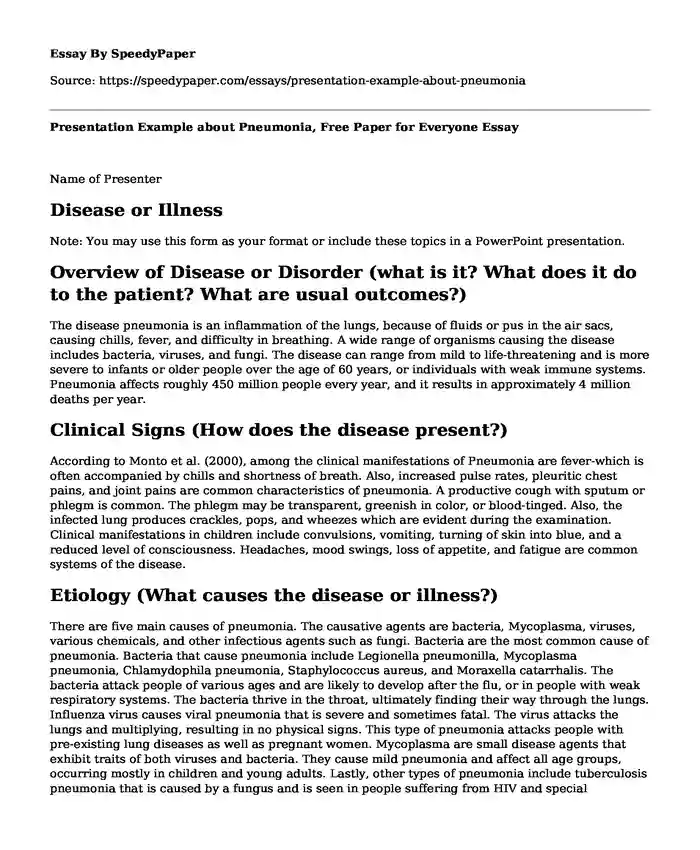
| Type of paper: | Presentation |
| Categories: | Presentation Medicine |
| Pages: | 3 |
| Wordcount: | 724 words |
Name of Presenter
Disease or Illness
Note: You may use this form as your format or include these topics in a PowerPoint presentation.
Overview of Disease or Disorder (what is it? What does it do to the patient? What are usual outcomes?)
The disease pneumonia is an inflammation of the lungs, because of fluids or pus in the air sacs, causing chills, fever, and difficulty in breathing. A wide range of organisms causing the disease includes bacteria, viruses, and fungi. The disease can range from mild to life-threatening and is more severe to infants or older people over the age of 60 years, or individuals with weak immune systems. Pneumonia affects roughly 450 million people every year, and it results in approximately 4 million deaths per year.
Clinical Signs (How does the disease present?)
According to Monto et al. (2000), among the clinical manifestations of Pneumonia are fever-which is often accompanied by chills and shortness of breath. Also, increased pulse rates, pleuritic chest pains, and joint pains are common characteristics of pneumonia. A productive cough with sputum or phlegm is common. The phlegm may be transparent, greenish in color, or blood-tinged. Also, the infected lung produces crackles, pops, and wheezes which are evident during the examination. Clinical manifestations in children include convulsions, vomiting, turning of skin into blue, and a reduced level of consciousness. Headaches, mood swings, loss of appetite, and fatigue are common systems of the disease.
Etiology (What causes the disease or illness?)
There are five main causes of pneumonia. The causative agents are bacteria, Mycoplasma, viruses, various chemicals, and other infectious agents such as fungi. Bacteria are the most common cause of pneumonia. Bacteria that cause pneumonia include Legionella pneumonilla, Mycoplasma pneumonia, Chlamydophila pneumonia, Staphylococcus aureus, and Moraxella catarrhalis. The bacteria attack people of various ages and are likely to develop after the flu, or in people with weak respiratory systems. The bacteria thrive in the throat, ultimately finding their way through the lungs. Influenza virus causes viral pneumonia that is severe and sometimes fatal. The virus attacks the lungs and multiplying, resulting in no physical signs. This type of pneumonia attacks people with pre-existing lung diseases as well as pregnant women. Mycoplasma are small disease agents that exhibit traits of both viruses and bacteria. They cause mild pneumonia and affect all age groups, occurring mostly in children and young adults. Lastly, other types of pneumonia include tuberculosis pneumonia that is caused by a fungus and is seen in people suffering from HIV and special pneumonia caused by inhalation of food and dust.
Epidemiology (The incidence, distribution, and control of disease in a population.)
Pneumonia infection rates are highest in developing countries, particularly in Africa and Southeast Asia, due to sub-optimal infrastructure, poor sanitation, and increased poverty. The infection results in high mortality rates in children and is a major cause of death in children under the age of 5 years. Pneumonia is a major concern in adults over the age of 65 years in developed nations, and approximately 26,000adults die from pneumonia every year. This is linked to increased aging, and presence of other chronic illnesses such as diabetes and heart disease.
Diagnostic Evaluation (examination, labs, etc.)
Blood tests taken during diagnostic evaluation of pneumonia to confirm an infection or identify the causative agent include FBC, EUC, and LFT. In addition, chest X-rays determine the location and extent of infection, while sputum cultures pinpoint infection causes. Pneumococcal urinary antigen assays, throat swabs to identify respiratory viruses, Chlamydia, Legionella, and Mycoplasma serology, and Legionella urinary antigen are tests that identify causing bacteria and viruses (Salisbury et al. 2017). Pulse oximetry measures oxygen levels in the blood.
Treatment (therapeutic or pharmacologic interventions) Treatment for pneumonia involves curing the infection and preventing further complications. Option treatment includes administering antibiotics, cough medicine, and fever inducers. Conventional drugs used for pneumonia treatment are azithromycin, clarithromycin, and erythromycin (Salisbury et al. 2017).
3 Sources of Information
Salisbury, M. L., Myers, J. L., Belloli, E. A., Kazerooni, E. A., Martinez, F. J., & Flaherty, K. R. (2017). Diagnosis and treatment of fibrotic hypersensitivity pneumonia. Where we stand and where we need to go. American journal of respiratory and critical care medicine, 196(6), 690-699.
Mandell, L. A. (2015). Community-acquired pneumonia: An overview. Postgraduate medicine, 127(6), 607-615.
Monto, A. S., Gravenstein, S., Elliott, M., Colopy, M., & Schweinle, J. (2000). Clinical signs and symptoms predicting influenza infection. Archives of internal medicine, 160(21), 3243-3247.
Cite this page
Presentation Example about Pneumonia, Free Paper for Everyone. (2022, Jun 15). Retrieved from https://speedypaper.com/essays/presentation-example-about-pneumonia
Request Removal
If you are the original author of this essay and no longer wish to have it published on the SpeedyPaper website, please click below to request its removal:
- Finance Related Article Review Exampe
- Lending Institutions, Health Care, and Human Capital: Kenya, Economics Essay Example
- "Dead Scared" Essay Sample
- Free Essay Example - Microsoft Project
- Essay Sample on Why People Should Be Against Globalization
- Reflective Essay Sample on Bowling
- Post-Operative Infection - Free Paper Sample
Popular categories




